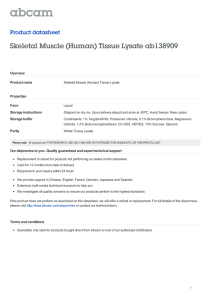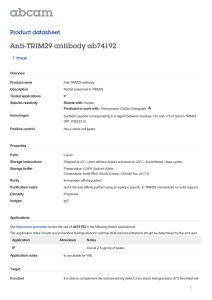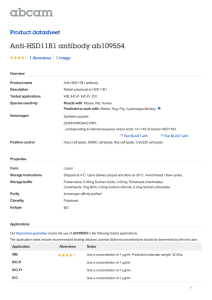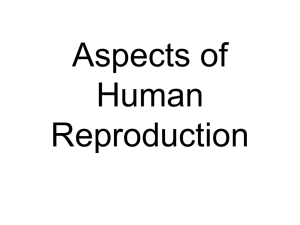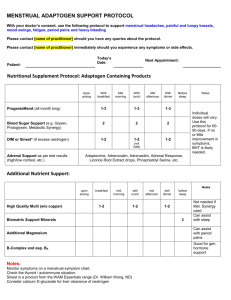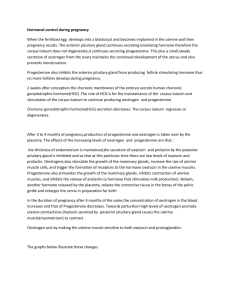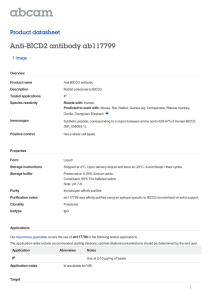Lincoln University Digital Thesis
advertisement
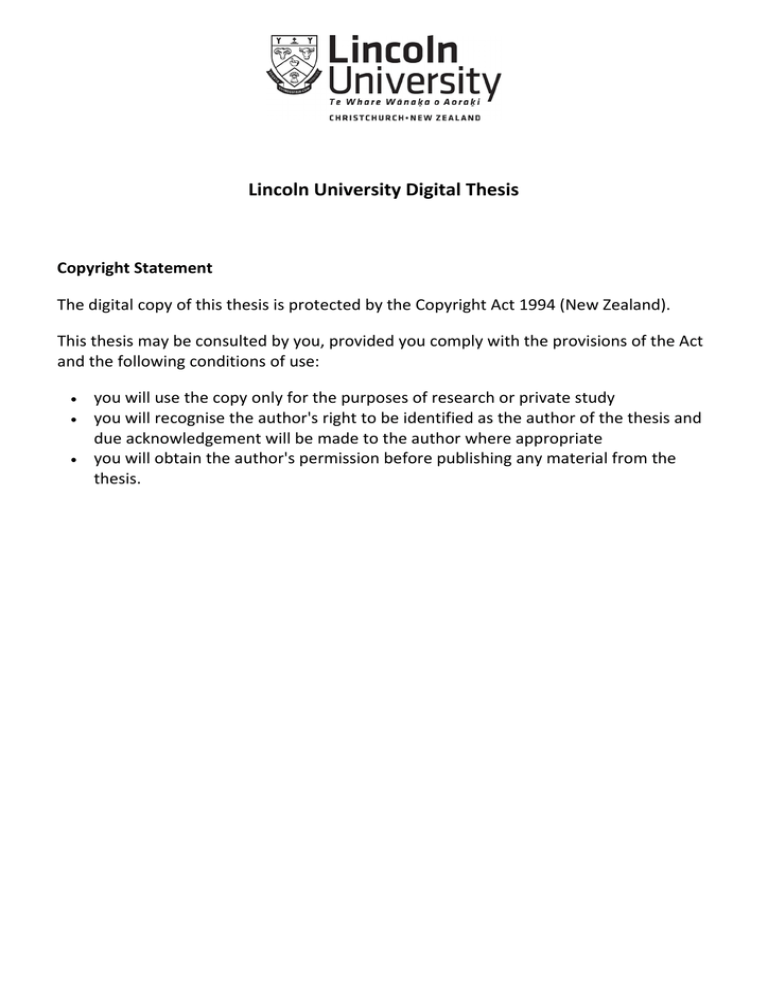
Lincoln University Digital Thesis Copyright Statement The digital copy of this thesis is protected by the Copyright Act 1994 (New Zealand). This thesis may be consulted by you, provided you comply with the provisions of the Act and the following conditions of use: you will use the copy only for the purposes of research or private study you will recognise the author's right to be identified as the author of the thesis and due acknowledgement will be made to the author where appropriate you will obtain the author's permission before publishing any material from the thesis. Biosensors and Bioelectronics 26 (2011) 3737–3741 Contents lists available at ScienceDirect Biosensors and Bioelectronics journal homepage: www.elsevier.com/locate/bios Electrochemical detection of oestrogen binding protein interaction with oestrogen in Candida albicans cell lysate Venkata Chelikani a , Frankie J. Rawson b , Alison J. Downard b , Ravi Gooneratne a , Gotthard Kunze c , Neil Pasco d , Keith H.R. Baronian e,∗ a Faculty of Agriculture and Life Sciences, Lincoln University, PO Box 84, Lincoln University, Lincoln 7647, Canterbury, New Zealand Department of Chemistry, University of Canterbury, Private Bag 4800 Christchurch, New Zealand Leibniz Institute of Plant Genetics and Crop Plant Research (IPK), Corrensstr. 3, D-06466 Gatersleben, Germany d Lincoln Ventures Ltd, PO Box 133, Lincoln, Christchurch 7640, New Zealand e School of Biological Sciences, University of Canterbury, Private Bag 4800 Christchurch, New Zealand b c a r t i c l e i n f o Article history: Received 21 October 2010 Received in revised form 8 January 2011 Accepted 13 January 2011 Available online 20 January 2011 Keywords: Oestrogen assay Yeast oestrogen binding protein (EBP) NADH Electrochemical detection Voltammetry a b s t r a c t Previously we reported an electrochemical method to quantitatively detect vertebrate oestrogens using wild type Saccharomyces cerevisiae cells. That assay required the use of a double mediator system, a fivehour incubation period and had a maximum detection limit of around 11 nM 17-oestradiol. In the work reported here we have sought to systematically increase the utility and decrease the complexity of the whole cell assay. The steps we took to achieve this goal were in order; lysing the cells to remove transport constraints, removing the lipophilic mediator and conducting the assay with the hydrophilic mediator only and finally performing the assay in a complex medium to demonstrate its specificity. Linear sweep voltammetry was used to investigate the interaction of mediators with NADH. The assay is now cell free and functions in a complex substrate. The linear response range upper limit has been raised to 100 nM with a calculated limit of detection of 0.005 nM with a limit of determination of 0.014 nM and the assay period has been reduced to 20 min. © 2011 Published by Elsevier B.V. 1. Introduction The need to detect environmental oestrogens and oestrogen analogues has been discussed in a number of publications, for example Kavlock et al. (1996), US Environmental Protection Agency (EPA US) (1997), Diamanti-Kandarakis et al. (2009) and environmental guidelines setting contamination limits have been/are being developed by some authorities, e.g., EC (1999), EPA US (1996a,b) and more recently Registration, Evaluation and Authorisation of Chemicals (REACH) (2006) and EPA US (2006). In response to the establishment of these guidelines a number of bioassays that will detect oestrogen and oestrogenic molecules, such as xenoestrogens and phytoestrogens in formats that enable rapid analysis have been developed. Unlike the conventional assay systems such as GCMS and HPLC assay systems, which can identify and quantify each oestrogen in a mixture of estrogens, the bioassays report an oestrogen equivalence (EEQ), which gives the oestrogenic potency of the sample as an equivalent concentration of 17 oestradiol. Importantly, the EEQ value gives a measure of the biological activ- ∗ Corresponding author. Tel.: +64 3 364 2987x7029. E-mail addresses: keith.baronian@canterbury.ac.nz, Xbaroniank@cpit.ac.nz (K.H.R. Baronian). 0956-5663/$ – see front matter © 2011 Published by Elsevier B.V. doi:10.1016/j.bios.2011.01.016 ity of the sample rather than the concentration of oestrogens in the sample. In general these bioassays still require specialised laboratories and highly skilled staff. Assays using mammalian cells and tissues provide the lowest levels of detection but are complex and time consuming while assays based on competitive receptor binding are fast but their detection limits are higher. Genetically modified yeast systems containing a vertebrate oestrogen receptor or its binding region and a reporter gene have been constructed to provide simple alternative assay methods. Most of these assays use the human oestrogen receptor and provide relatively sensitive methods to detect EEQ (Schultis and Metzger, 2004). S. cerevisiae and several other species of yeast are known to have an oestrogen binding protein (EBP) (Feldman et al., 1982; Restrepo et al., 1984; Skowronski and Feldman, 1989) that mediates the oxidation of NAD(P)H to provide NAD(P)+ for the cells catabolic processes. Oestrogens, particularly17 oestradiol, can bind to the NAD(P)H oxido-reductase site and block its function and as a result the concentration of NAD(P)H in the cell rises (Madani et al., 1994; Baronian and Gurazada, 2007). Baronian and Gurazada (2007) used S. cereviseae as the biorecognition element in a non-genetically modified yeast oestrogen assay. A double mediator electrochemical system comprising ferricyanide and 2,3,5,6-tetramethyl-1,4-phenylenediamine (TMPD) was used to detect NAD(P)H levels in the cell. As the concentration of 3738 V. Chelikani et al. / Biosensors and Bioelectronics 26 (2011) 3737–3741 oestrogen increased, so did the concentration of NAD(P)H and consequently, that of ferrocyanide, which was detected at the end of an incubation period by linear sweep voltammetry (LSV). The assay gave responses to other vertebrate oestrogens but not to a synthetic oestrogen. The assay was very sensitive with a linear response from 3.67 × 10−13 M to 3.67 × 10−9 M and calculated limits of detection and determination of 3.6 × 10−15 M and 2.1 × 10−14 M, respectively, with an EC50 of 6.25 × 10−13 M. This compares favourably with other oestrogen assays, which mostly have limits of detection (LoD) for 17-oestradiol of between 1 × 10−12 M and 5 × 10−9 M (Kaiser et al., 2010; Leskinen et al., 2005). The response was linear up to 1.1 × 10−8 M, however, at 2.0 × 10−8 M the response plummeted and the downward trend continued at 5.5 × 10−8 M. Our explanation for this phenomenon was that the ABC transporters that export oestrogen from the cell are not activated until the concentration of oestrogen rises above 11 nM. Once it has reached this level oestrogen is rapidly transported out of the cell reducing its blocking effect on EBP, an explanation that is supported by the work of Cheng et al. (2006). This limitation on the upper concentration that can be detected is a problem common to all yeast cell assays and generally requires sample dilution to remedy. While the LoDs of many oestrogen assays are suitable for analysis, raising the upper limit would improve the utility of these methods. The minimum incubation period required for the S. cerevisiae assay is around 5 h. While this is very good in comparison with the incubation period required for the yeast oestrogen screen (YES) of three days (Routledge and Sumpter, 1996), it cannot be classified as a rapid test. Some recent yeast oestrogen assays have reported shorter incubation periods, e.g., 2.5 h in modified S. cerevisiae containing an oestrogen receptor with firefly luciferase controlled by a hormone responsive promoter as the reporter (Leskinen et al., 2005), 0.5 h for an automated 17 oestradiol immunoassay system (Tanaka et al., 2004), and 2 min with a carbon nanotube field effect transistor functionalised with oestrogen receptor ␣ measuring bisphenol A (Sanchez-Acevedo et al., 2009). EBP will only bind to vertebrate oestrogens, which contrasts with oestrogen assays based on the vertebrate oestrogen receptor element and oestrogen receptor, which respond to oestrogens, xenoestrogens and phytoestrogens (Skowronski and Feldman, 1989). This gives the EBP assay a unique property that can be exploited to measure vertebrate estrogens only, or if used in conjunction with an ERE/ER system, will enable the EEQ of xenoestrogens to be quantified. Candida albicans also expresses an EBP and this organism is because its EBP and the corresponding gene are fully characterised (Madani et al., 1994). The objective of these investigations was to simplify the use of mediators in the detection of oestrogen/EBP binding, increase the dynamic range of the assay and to reduce the assay period to that of a rapid test. 2. Methods 2.1. Cells C. albicans CDC S-24 was purchased from ESR, Porirua, New Zealand and maintained on YEPD agar plates at 4 ◦ C. 2.2. Cultivation of cells C. albicans was cultivated in YEPD broth, a general-purpose fungal-selective medium (yeast extract 10 g Merck, peptone 110 20 g GibcoBRL, dextrose 20 g BDH Analar, per liter). Cells were incubated at 37 ◦ C for 16 h in indented flasks shaken at 180 rpm, and harvested by centrifugation (2604 × g, 8 min, 10 ◦ C), washed twice in phosphate buffered saline (PBS) pH 7 and then re-suspended in PBS pH 7 at OD600 = 3.0. 2.3. Reagents Potassium hexacyanoferrate (III) (K3 FeCN6 , Merck pro analysis) was dissolved in distilled water; 0.5 M, 2,3,5,6-tetramethyl-1,4phenylenediamine (TMPD, Aldrich) was dissolved in 96% ethanol, 20 mM, and 17-oestradiol (Sigma) was dissolved in 96% ethanol, 300 g L−1 . Lyticase from Arthrobacter luteus, chitanase from Trichoderma viride, -glucurinidase type H2 from Helix pomatia and dl-dithiothreitol were purchased from Sigma. All solutions were sterilised by filtration (0.45 m Millipore) and stored at 4 ◦ C. OECD synthetic waste water was made by mixing160 mg peptone, 10 mg meat extract, 30 mg urea, 28 mg K2 HPO4 , 7 mg NaCl, 4 mg CaCl2 , 2 mg MgSO4 ·7H2 O in 1 L H2 O (mean COD concentration 263 mg L−1 ) (OECD Technical Report, 1976). 2.4. Production of cell lysate A cell suspension OD600nm 3 was pre-incubated for 15 min with 2 mM dithiothreitol and then incubated with 50 mL of lyticase (100 units/mL), 16 units of chitinase, and 200,000 units of glucuronidase and protease inhibitor cocktail (leupeptin (Sigma), pepstatin (Sigma), chymostatin (Sigma), benzamidine (Fluka) and trypsin inhibitor (Fluka)) for 3 h at 30 ◦ C at 50 rpm. Treated cells were harvested by centrifugation for 15 min at 18,514 × g. The supernatant containing the disrupted cells was removed, shaken vigorously for 2 min and passed through 0.45 m filter (Millipore) to remove any debris. It was stored at 4 ◦ C until use. 2.5. Experimental procedure The cell incubation and electrochemical detection methods are those previously described Baronian and Gurazada (2007). The electrochemical analyser was an eDAQ potentiostat coupled to a Power Lab 2/20 controlled by eDAQ Echem software. The electrodes for all experiments unless stated was 100 m diameter Pt microdisc working electrode, a Ag/AgCl reference electrode and a Pt wire auxiliary electrode, all G-Glass, Australia. The Pt microdisc electrode was polished on a Lecloth polishing cloth (Leco) using a slurry of 0.3 m alumina (Leco) prior to each scan. Experimental samples comprising the following were prepared: either 4065 L whole cell suspension or cell lysate, 800 L ferricyanide solution (incubation concentration 80 mM), 125 L TMPD solution (incubation concentration 0.5 mM), 100 L oestrogen solution (incubation concentrations of 1 nM to 200 nM) and ethanol (100 L or less in endogenous control groups and oestrogen groups where required). Note the cell lysate of 4065 L is extracted from an equivalent number of cells that are present in 4065 L of whole cell suspension. The experimental samples were incubated at 37 ◦ C with oxygen-free nitrogen sparging for 5 h for cell samples and initial lysate samples. Subsequent lysate sample where incubated for 10–120 min. At the completion of incubation, the cells were pelleted by centrifugation (4629 × g, 20 ◦ C for 10 min) and the supernatant removed for voltammetric analysis. All trials were run in triplicate and included a negative control to determine the base level endogenous catabolic activity (cell trials) or redox activity (lysate trials) and are referred to as the control in the results. The supernatant of each sample was analysed in triplicate using LSV. Steady-state voltammograms were obtained at a scan rate of 5 mV s−1 scanning from 450 mV to 130 mV. Steady state currents were established from the LSV plateau current above the half wave potential of the Fe2+ /Fe3+ couple. This anodic plateau current (quantified at E = 425 mV) was used as a relative measure of the V. Chelikani et al. / Biosensors and Bioelectronics 26 (2011) 3737–3741 3739 Fig. 1. C. albicans whole cell and cell lysate responses in the presence and absence of 17 oestradiol (E) 10 nM using a double mediator system (ferricyanide and TMPD). The data points are the steady state currents obtained by LSV after 5 h incubation. Error bars represent ±1SD. Fig. 2. C. albicans whole cell and cell lysate responses to 17-oestradiol (E) 10 nM using a single hydrophilic mediator (ferricyanide). The data points are the steady state currents obtained by LSV after a 5 h incubation. Error bars represent ±1SD. amount of ferrocyanide produced (Baronian et al., 2002) and hence the number of cell redox molecules oxidized by TMPD, either in relation to yeast catabolism and/or the EPB/oestrogen/NADH oxidase interaction. In later lysate experiments TMPD was removed from the incubation mix and ferricyanide only was used to monitor the activity of EBP. The limit of detection was calculated by the blank-value procedure from the blank sample B, the variation of the blank sample sB, and empirical factors. Limit of detection is given by: yL = B + 4.65sB and limit of determination is given by yD = B + 14.1sB. Error bars are 1 standard deviation and P values were established by ANOVA. OECD wastewater incubations were prepared as follows: 3600 L cell lysate, 800 L ferricyanide solution (final concentration 80 mM) and 300 L PBS. The two controls were 166 L ethanol, 434 L PBS, and OECD wastewater 300 L, ethanol 166 L, 134 L PBS. Oestrogen trials were 300 L OECD wastewater, 166 L ethanol with oestrogen to give final concentrations of 5, 10, 25 nM, and 134 L PBS. The HPLC analysis was with an Agilent 1100series HPLC (Agilent, USA) with Chemstation software. The column was a Prodigy 250 mm × 4.6 mm reverse phase column (Phenomenex, USA). Solvent A was 0.01 M NaH2 PO4 and B was methanol. The gradient used was 95% A + 5% B. Detection was by UV at 260 nm and 340 nm. Injected quantity was 5 L. responses to 10 nM 17 -oestradiol can be detected at 20 min. In 5 h incubation the difference between the control and sample signal was greater (approximately 500 nA, Fig. 1) indicating the divergence of the signals continued beyond 80 min. HPLC analysis for NADH showed that its concentration in cell lysate with oestrogen was approximately twice that in cell lysate without oestrogen, which supports the role of oestrogen in EBP function outlined in the introduction. The plot of the cell lysate responses to oestrogen shown in Fig. 4 is a composite of two experiments exploring the lower and upper ranges of the dose response curve. These ranges are at the lower limit to beyond the upper limit of the S. cereviseae whole cell response range (Baronian and Gurazada, 2007). The calculated limit of detection is 0.005 nM with a limit of determination of 0.014 nM. The control responses have been subtracted from the responses due to oestrogen. Fig. 5a shows that the response to oestrogen in both cells and cell lysate declines over 20 days. However, the endogenous response of whole cells remained almost constant over the same period suggesting that the loss in response is due to the loss of activity of EBP (Fig. 5b). 800 (+) estrogen 3. Results 700 (- ) estrogen 600 Current (nA) C. albicans whole cells and cell lysate were incubated with ferricyanide and TMPD for 8 h with and without17-oestradiol. Fig. 1 shows that there is a detectable response to the presence of oestrogen in both whole cell and cell lysate trials. In this experiment 10 nM oestrogen was used as the analyte for both whole cells and cell lysate. Cell lysate responses are approximately three times larger than those seen in the whole cell trials. Whole cells and cell lysate were incubated for 8 h with ferricyanide as the sole mediator. Fig. 2 shows that there is a small and equal response detectable in whole cells both with and without oestrogen. In the cell lysate, however, the responses are much larger than the whole cell responses, both with and without oestrogen, and the with-oestrogen response is larger than the without-oestrogen response. The response time to oestrogen in the lysate system is shown in Fig. 3. In the absence of cell structure the response time is reduced and the difference between endogenous catabolism (control) and 500 400 300 200 100 0 0 20 40 60 80 100 Time (min) Fig. 3. C. albicans lysate control (endogenous) responses and responses to 17oestradiol 10 nM obtained from incubations ranging from 10 to 80 min. The data points are the steady state currents obtained by LSV. Error bars represent ±1SD. 3740 V. Chelikani et al. / Biosensors and Bioelectronics 26 (2011) 3737–3741 300 R 2 = 0.982 250 Current (nA) 200 150 100 50 0 0.01 -50 0.1 1 10 100 1000 17β-oestradiol log (concentraon/nM) Fig. 4. C. albicans cell lysate responses to 17-oestradiol were explored in two experiments 0.01–0.5 nM and 5–200 nM oestrogen. Both experiments are plotted. Responses due to the background (controls 342 nA and 315 nA, respectively) have been subtracted from the oestradiol responses. Error bars represent ±1SD. OECD synthetic wastewater was spiked with oestrogen and LSVs were performed after incubation with lysate. Fig. 6 shows that increasing concentrations of oestrogen are detectable in this complex matrix and that there is no detectable background response to the synthetic wastewater alone. Fig. 5. (a) C. albicans whole cell and cell lysate responses to 17 oestradiol 10 nM over 20 days (b) stability of the oestrogen response in whole cells over 20 days. The cell response is relatively constant over 20 days while the oestrogen response declines over the same period. Error bars represent ±1SD. Fig. 6. Responses to 17-oestradiol (E) (5, 10 and 25 nM) in an OECD synthetic waste matrix, final CoD = 15.8. Responses from the lysate and lysate plus OECD synthetic wastewater controls are the same (P = 0.6348). 4. Discussion Baronian and Gurazada (2007) used a double mediator system comprising ferricyanide and 2,3,5,6-tetramethylphenyldiamine (TMPD) with S. cereviseae whole cells for the detection of oestrogen. TMPD is a lipophilic mediator that can enter the cell and be reduced by NAD(P)H and redox molecules of the electron transport chain. Reduced TMPD exits the cell and reduces hydrophilic (and therefore extracellular) ferricyanide to ferrocyanide. The ferrocyanide is detected electrochemically with the signal directly related to the number of electrons removed from the redox molecules oxidized by TMPD, either in yeast catabolism and/or the EPB/oestrogen/NAD(P)H interaction. The maximum current detected was at 11 nM oestrogen, which is a similar concentration to maximum signals reported for other whole cell oestrogen assays (Beresford et al., 1999; Rehmann et al., 1999; Fine et al., 2006; Leskinen et al., 2005). This work was repeated with C. albicans to establish its response parameters to oestrogens before undertaking C. albicans lysate trials. The responses were observed with C. albicans whole cells were similar to those reported for S. cereviseae. Fig. 1a shows that cell lysate responses 17 oestradiol are much higher than the response seen with whole cells. The higher signals are probably due to the absence of a cell membrane, which exerts rate limitations on the entry of oestrogen into the cells and perhaps on the export of reduced TMPD. Removal of this barrier permits the reactants to behave as molecules in solution and increases the overall rate of reaction, because barriers to diffusion no longer exist. Yeast cells have, in addition to the intracellular redox centres, transmembrane electron transport proteins (tPMETs, also known as plasma membrane oxidoreductases, PMOR), which transfer electrons from the cell interior to the external surface of the cell membrane. Common electron donors are NADH and NADPH and common extracellular acceptors are Fe3+ (uptake of iron), oxygen (maintenance of catabolism) and ascorbate free radical (AFR) defence systems (Ly and Lawen, 2003). Fig. 2 shows the cell signals with ferricyanide are small and are the same with and without oestrogen. This is because the hydrophilic ferricyanide can only access the external component of tPMETs and cannot cross the cell membrane to access catabolic redox molecules. The use of ferricyanide with the lysate, however, produces a response equivalent to that seen in the ‘with’ and ‘without’ oestrogen double mediated whole cell trials because it is not excluded by a cell membrane. This is simplification of this assay in that only a single hydrophilic mediator is required. V. Chelikani et al. / Biosensors and Bioelectronics 26 (2011) 3737–3741 There is a dramatic decrease in the signal at high 17 oestradiol concentration in the S. cereviseae oestrogen bioassay (Baronian and Gurazada, 2007). This decrease is also seen in hER/ERE modified yeast cells although the decrease is less dramatic (Schultis and Metzger, 2004; Beresford et al., 1999). The reason is not clearly understood, however, Cheng et al. (2006) state that microarray studies show that increased 17-oestradiol increases the transcription of the genes CDR1 and CDR2, which seem to be related to an increase the production of efflux pumps which remove 17estradiol from C. albicans cell. Removal of the cell membrane allows EBP/oestrogen/NADH interactions to proceed without concentration limiting cell membrane regulatory mechanisms, which increases the dynamic range of the assay to 100 nM. These experiments have been successful in significantly reducing the incubation time to make it comparable with the most rapid oestrogen assays reported to date. Fig. 3 suggests that it may be possible to reduce this period further by increasing the concentration of EBP, i.e., the time taken to enable the detection of the response is concentration dependant and not event dependant. While the oestrogen response in both whole cells and cell lysate declines over twenty days (Fig. 5a) the control response of whole cells (Fig 5b) and lysate remain relatively constant over the same period. This indicates that the loss of oestrogen response is due to the loss of EBP activity. Use of EBP in a long use-by-date sensor will thus require stabilisation of the molecule. The whole cell assay referred to earlier was sensitive to background catabolic molecules and controls were required to remove this effect. In lysate experiments with OECD synthetic waste as the background there was no response to the waste but quantitative responses to oestrogens were clearly detectable. This is a further simplification over the whole cell assay in that the effect of the background on the oestrogen signal is reduced. The assumptions that oestrogen blocks the reduction of NADH by EBP and that NADH is the source of electrons for both TMPD in whole cell experiments and ferricyanide in lysate experiments is supported by the HPLC analysis. NADH concentration in lysate samples is higher in lysate with oestrogen than in lysate without oestrogen (data not shown). This difference corresponds to the differences between the ‘with’ and ‘without’ oestrogen response in the double and single mediator trials shown in Fig. 1a and b and supports the notion that NADH a source of electrons for mediator reduction. Lysate detection of oestrogen in a complex substrate is shown in Fig. 6. The oestrogen responses are clearly distinguishable from the lysate only and synthetic waste controls. There is also no difference between the two controls (P = 0.6348) indicating that disruption of the cell has prevented a catabolic response to the waste. This is a distinct advantage over the whole cell assay where the background catabolic response had to be controlled with glucose (Baronian and Gurazada, 2007). 5. Conclusions This work has successfully transferred a method for detection of oestrogens using a wild type S. cereviseae to a wild type C. albi- 3741 cans as the assay catalyst. The use of cell lysate from C. albicans has reduced the assay time to minutes and increased the dynamic range 10 fold. The assay can also be used in a complex matrix without interference from catabolic substrates. Furthermore we have demonstrated that lysate stored at 4 ◦ C is sufficiently active over 8 days for use in analysis. Acknowledgements Funding for this research was from the Royal Society of New Zealand, Marsden Fund (contract UOC 0605) and the New Zealand Foundation for Research, Science and Technology (contract PROJ13838-NMTS-LVL). References Baronian, K.H.R., Downard, A.J., Lowen, R.K., Pasco, N., 2002. Appl. Microbiol. Biotechnol. 60, 108–113. Baronian, K.H.R., Gurazada, S., 2007. Biosens. Bioelectron. 22 (11), 2493–2499. Beresford, N., Routledge, E.J., Harris, C.A., Sumpter, J.P., 1999. Toxicol. Appl. Pharmacol. 162, 22–33. Cheng, G., Yeater, K.M., Hoyer, L.L., 2006. Eukaryote Cell 5, 180–191. Diamanti-Kandarakis, E., Bourguignon, J.-P., Giudice, L.C., Hauser, R., Prins, G.S., Soto, A.M., Zoeller, R.T., Gore, A.C., 2009. Endocr. Rev. 30 (4), 293–342. EC, 1999. Community Strategy for Endocrine Disrupters, Rep.No. COM (99)706. European Commission, Brussels. Environmental Protection Agency, USA. 2006. Endocrine Disrupter Screening Program (EDSP), Implementing the Screening and Testing Phase, The Regulatory Plan 72875. Environmental Protection Agency, USA, 1996a. Food Quality Protection Act of 1996. Public Law 104–170. Environmental Protection Agency, USA, 1996b. Safe drinking water act amendments of 1996. Public Law 104–182. Environmental Protection Agency, USA, 1997. Special report on environmental endocrine disruption: an effects assessment and analysis. EPA/630/R-012, Washington, DC, February. Feldman, D., Do, Y., Burshell, A., Stathis, P., Loose, D.S., 1982. Science 218, 297–298. Fine, T., Leskinen, P., Isobe, T., Shiraishi, H., Morita, M., Marks, R.S., Virta, M., 2006. Biosens. Bioelectron. 21, 2263–2269. Kaiser, C., Uhlig, S., Körner, M., Simon, K., Kunath, K., Florschuutz, K., Baronian, K., Kunze, G., 2010. Sci. Total Environ., doi:10.1016/j.scitotenv. 2010.08.050. Kavlock, R.J., Daston, G.R., DeRosa, C., Fenner-Crisp, P., Gray, L.E., Kaattari, S., Lucier, G., Luster, M., Mac, M.J., Maczka, C., Miller, R., Moore, J., Roland, R., Scott, G., Sheehan, D.M., Sinks, T., Tilson, H.A., 1996. Environ. Health Perspect. 104 (l4), 715–740. Leskinen, P., Michelini, E., Picard, D., Karp, M., Virta, M., 2005. Chemosphere 61, 259–266. Ly, J.D., Lawen, A., 2003. Redox Rep. 8 (1), 3–21. Madani, N.D., Malloy, P.J., Rodriguez-Pombo, P., Krishnan, A.V., Feldman, D., 1994. Proc. Natl. Acad. Sci. 91, 922–926. OECD Technical Report Proposed method for the determination of the biodegradability of surfactants used in synthetic detergents, June 11, 1976. Sanchez-Acevedo, Z.C., Riu, J., Rius, X.F., 2009. Biosens. Bioelectron. 24 (9), 2842–2846. Rehmann, K., Schramm, K.-W., Kettrup, A., 1999. Chemosphere 38 (14), 3303–3312. Restrepo, A., Salazar, M.E., Cano, L.E., Stover, E.P., Feldman, D., Stevens, D.A., 1984. Infect. Immun. 46, 346–353. Routledge, E.J., Sumpter, J.P., 1996. Environ. Toxicol. Chem. 15 (3), 241–248. Registration, Evaluation, Authorisation and Restriction of Chemicals (REACH), 2006. REGULATION (EC) No 1907/2006 of the european parliament and of the council of 18 December. Skowronski, R., Feldman, D., 1989. Endocrinology 124, 1965–1972. Schultis, T., Metzger, J.W., 2004. Chemosphere 57, 1649–1655. Tanaka, T., Takeda, H.Ueki., Obata, I., Tajima, K., Takeyama, H., Goda, H., Fujimoto, Y., Matsunaga, S.T., 2004. J. Biotechnol. 108, 153–159.
